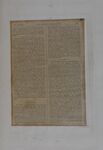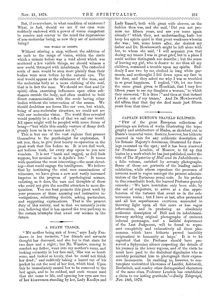< The Progress of Psychology (continued from page 10-118) >
But, if everywhere, in what condition of existence? What, in fact, should we see if our eyes were suddenly endowed with a power of vision competent to receive and convey to the mind the impressions of non-molecular being, as now they are of molecular being?
Without stirring a step, without the addition of an inch to the range of vision, within the circle which a minute before was a void about which was scattered a few visible things, we should witness a new world, thronged with inhabitants. The embodied souls of men would be seen more plainly than their bodies were seen before by the natural eye. The soul would appear as the substance of the man, and the molecular body as a mere clothing of the soul, that is in fact the man. We should see that soul (or spirit) often exercising influences upon other substances outside the body, and often enabled to hold direct communication with the souls having other bodies without the intervention of the senses. We should doubtless see forms like our own, but which, being of non-molecular structure, we could not see with our molecular vision. The world thus revealed would possibly be a reflex of that we call our world. All space might well be peopled with some forms of being—“but while this muddy vesture of decay doth grossly hem us in we cannot see it.”
This is but one of the vast regions that present themselves to the psychologist for exploration. I ask you, then, to give your hearty co-operation in the great work that lies before us. It is not dull work, nor tedious work, for every step opens to you new wonders. It is not “harsh and rugged, as dull fools suppose, but musical as is Apollo’s lute.” It teems with questions the most interesting—the most elevating—that could engage the intelligence. We believe that by instituting the viva, voce examinations of witnesses, we have given a new and vastly increased impetus to the progress of psychological science, enlisting, as it does, the ears and thoughts of those who could not give the needful attention to mere disquisition. You can best promote this great work by your presence at these amusing and instructive investigations, submitting doubts, asking particulars, and suggesting explanations. That is the present duty of this society, and to that we earnestly invite you, believing that it has opened the true pathway to the certain triumphs that await our science in the future.
A Death Trance
“My mother being sick of fever,” says Lady Fanshawe in her memoirs, “her friends and servants thought her deceased, and she lay in that state for two days and a night; but Mr. Winslow, coming to comfort my father, went into my mother’s room, and looking earnestly in her face said, ‘She was so handsome, and looked so lovely, that he could not think her dead;’ and suddenly taking a lancet out of his pocket he cut the soul of her foot, which bled. Upon this he immediately caused her to be removed to the bed again, and to be rubbed, and such means used that she came to life, and opening her eyes saw two of her kinswomen standing by her, Lady Knollys and Lady Russell, both with great wide sleeves, as the fashion then was, and she said, ‘Did you not promise me fifteen years, and are you come again already?’ which they, not understanding, bade her keep her spirits quiet in that great weakness wherein? she was; but, some hours after, she desired my father and Dr. Howlesworth might be left alone with her, to whom she said, ‘I will acquaint you that during my trance I was in great grief, but in a place I could neither distinguish nor describe; but the sense of leaving my girl, who is dearer to me than all my children, remained a trouble upon my spirits. Suddenly I saw two by me, clothed in long white garments, and methought I fell down upon my face in the dust, and they asked me why I was so troubled in so great happiness. I replied, “Oh, let me have the same grant given to Hezekiah, that I may live fifteen years to see my daughter a woman,” to which they answered, “It is done!” and then at that instant I awoke out of my trance,’ And Dr. Howlesworth did affirm that that day she died made just fifteen years from that time.”
Captain Burton's Travels Eclipsed
“Few of the great European collections of paintings are forlorn of works illustrating the topography and architecture of Hades, as sketched out in Dante’s immortal verse. Society, however, has hitherto yearned in vain for any authentic description of his Satanic Majesty’s dominions, illustrated by drawings executed on the spot; and it has been reserved for Professor Leuchin, of Moscow, to fill up this hiatus by a work which he has just published, under the title of The Mysteries of Hell and its Inhabitants—a folio volume, enriched by seventy photographs. Some of these are portraits of the leading native celebrities, while others reproduce the processes of torment most in vogue amongst the present administrators of the Tartarean penal code. In his preface to this remarkable book, the learned Professor gravely remarks: ‘We have heretofore only been able, by the aid of conjecture, to arrive at a dim apprehension of the tortures that await us in the subterranean realm; but I have at last, after protracted and all but superhuman exertions, succeeded in throwing light upon all this more or less vague information, and in producing an absolutely authentic description of Hell and its inhabitants. Seventy striking original photographs of eminent infernal personages, and a faithful depictment of the Last Judgment, will be found to represent completely and exhaustively all those phenomena which have hitherto proved insolubly enigmatical to humanity at large.’ It is to be regretted that the Professor should have preserved a Sphynxian silence respecting the details of his journey in the lower regions, and of the visits he must have paid to the diabolical dignitaries who so amiably permitted him to photograph their expressive lineaments. In enabling us, however, to contemplate undoubted likenesses of Lucifer, Ashtaroth, Beelzebub, and sundry other distinguished characters of the same class, Professor Leuchin has established a claim to our lasting gratitude.”—Daily Telegraph, Nov. 18th, 1879.
Editor's notes
Sources
-
London Spiritualist, No. 378, November 21, 1879, p. 251


